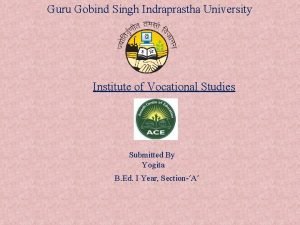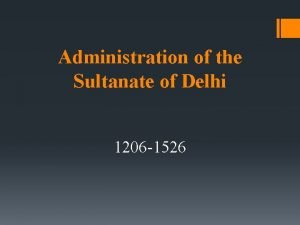DELHI SULTANATE TUGHLAQ PERIOD 1320 1413 WHAT WE










- Slides: 10

DELHI SULTANATE TUGHLAQ PERIOD 1320 - 1413

WHAT WE WILL LEARN • • • Establishment of Tughlaq Dynasty Ghiyasuddin Tughlaq Policies of Muhammad Bin Tughlaq Policies of Firuz Shah Tughlaq Art and Architecture under the Tughlaq Dynasty.

INTRODUCTION Alauddin Khalji greatly consolidated his empire, but after his death, the Khalji empire declined, this paved way for the emergence of Tughlaq dynasty of the Delhi Sultanate in the 14 th century. The Tughlaq dynasty was founded by Ghiyasuddin Tughlaq in the year 1320, his father was a bandgan ( slave) in the army of Balban and mother was of Indian origin.

GHIYASUDDIN TUGHLAQ When Ghiyasuddin ascended the throne of Delhi, the empire was hardly existent, some provinces had revolted and asserted their independence and the treasury was empty, it was therefore extremely important for the latter to restore the empire. Ghiyasuddin consolidated his empire conquering the Deccan and the East, but while celebrating his own victory he died in an accident when a structure fell on his head, this paved the way for his son Ulugh Khan to ascend the throne.

MUHAMMAD BIN TUGHLAQ • Ulugh Khan came to be known as Muhammad Bin Tughlaq. • After consolidation the empire in the Deccan and Bengal, he also strengthened the NWFP and extended his suzerainty to this part of the subcontinent. • Ibn Battuta, a Moroccan travellar, who visited India during this time, documented his thoughts in a book called Rehala. • Battuta also tells us about the small city of Adilabad, which was founded by Muhammad Tughlaq. • Battuta was made the Chief Wazir of Delhi by the Sultan!

ADMINSTRATIVE POLICIES UNDER MUHAMMAD TUGHLAQ • • • Muhammad Bin Tughlaq shifted the capital of the empire from Delhi to Devagiri in the Deccan. He also introduced token currency instead of gold and silver coins, this can be seen as the first experiments in establishing a modern day currency. He created an independent Department of Agriculture called ( Diwan –i- Kohi) and wali –ul – Kharaj for collective of revenue at provincial level. He reorganized the army based on the decimal system of the Mongols. He created the “famine code” for relief of people from recurrent famines.

FIRUZ SHAH TUGHLAQ • Firuz Shah was Muhammad’s nephew who ascended the throne of Delhi in September 1351. • Firuz was a trained administrator in all aspects of governance. • He appointed Khwaja Hisan - ud – din for making an assessment of the public revenue of the empire. • He constructed numerous canals for facilitating irrigation across the empire • He established the Diwan – i – Khairat for the poor and destitute • He even waived loans of peasants and farmers. • He started the process of granting land assignments to army personnel. • Created a Department of Slaves ( Diwan-I – Bandagan)

SOME POLICIES OF FIRUZ TUGHLAQ • He was very fond of building and was a architectural genius. • He financed the repair and restoration of numerous monuments such as Qutub Minar, Alai Darwan, Alai Tank, Iltutmish’s madarsa and even the city of Jahanpanah. • The details of the canals commissioned by him can be found in Tarikk - I – Mubarak Shahi. • He commissioned numerous sarais, hospitals and roads • He brought 2 Ashokan pillars to Delhi and installed one in his capital, Firozabad.

ART AND ARCHITECTURE UNDER THE TUGHLAQS • With the establishment of his empire, Ghiyassuddin envisaged a new capital and commissioned the Fort of Tughlaqabad to be centre of his governance, his tomb is also located adjacent to the fort, which though majestic now survives in ruins. • Muhammad bin Tughlaq also founded the city of Jahanpanah and merged it with the city of Siri. • Firuz Tughlaq is credited with founding Firozabad his new capital. • The Tughlaq monuments are massive structures with much lesser of ornamentation and design.

CONCLUSION The Tughlaq dynasty of the Delhi Sultanate ruled for almost 100 years, each of the rulers established a new city redefining governance and administrative policies. After the death of Firuz Shah, a weak line of successors could not consolidate the empire, which paved way for the Sayyids to rise to power in Delhi.

















